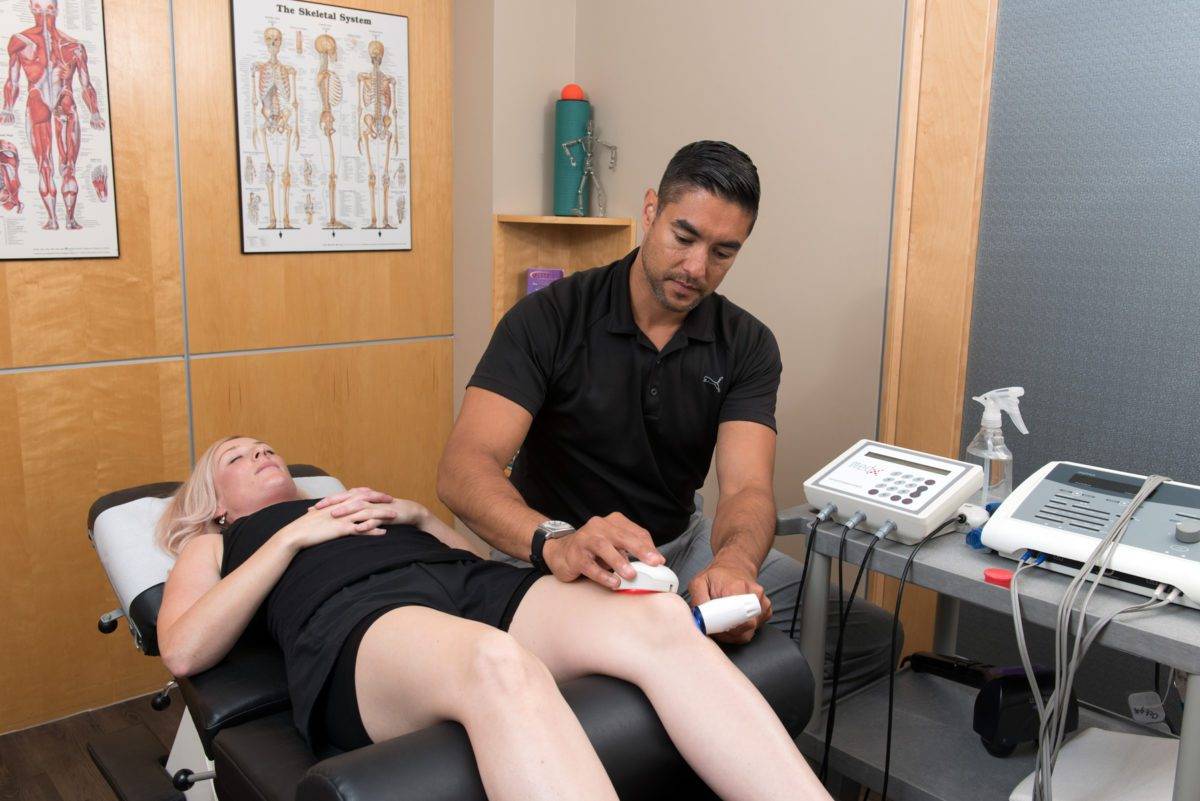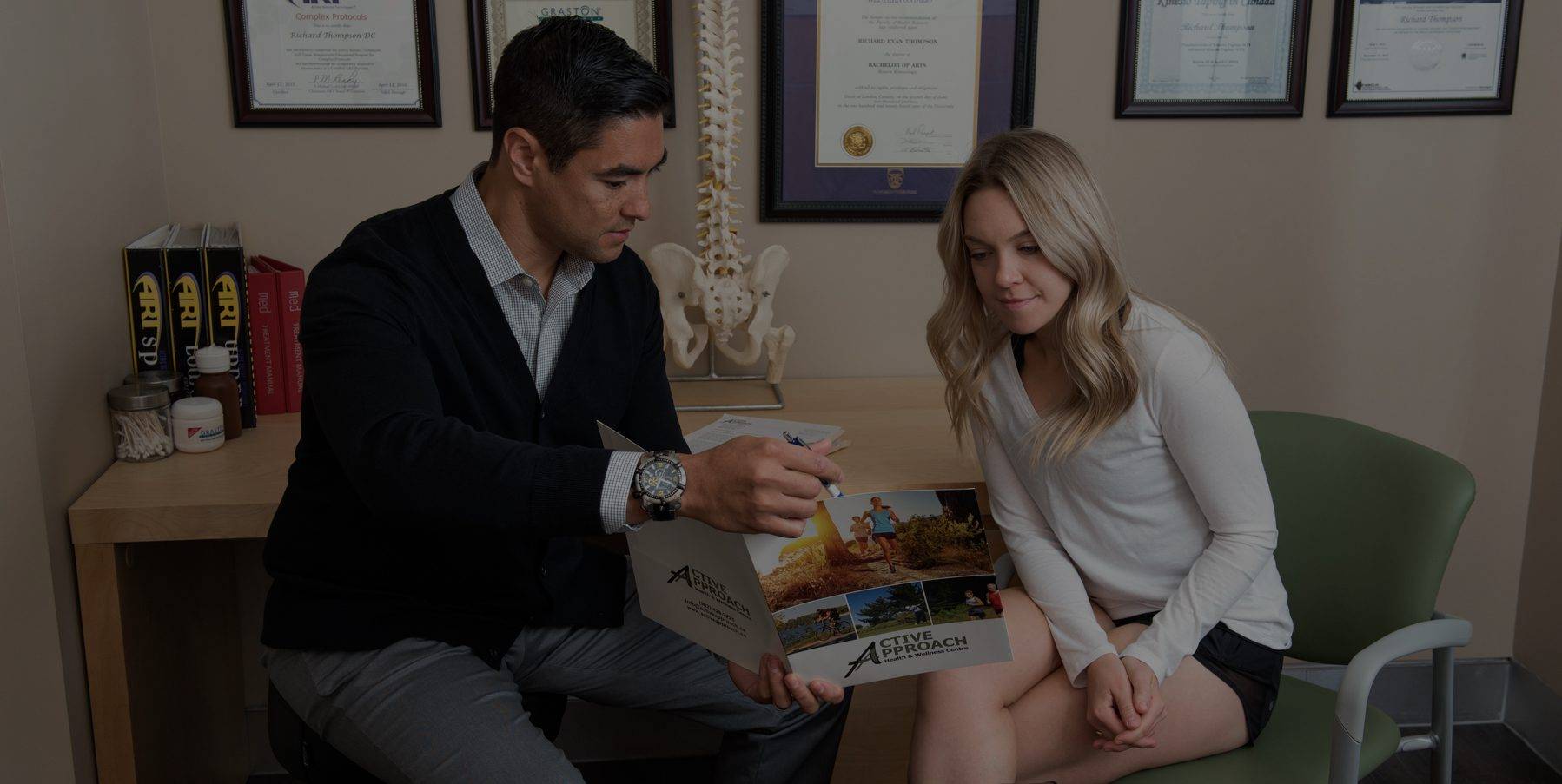By Dr. Richard Thompson, BA, DC, MBA
Do you ever sit back and wonder – how did I get here? I often get asked by patients what led me to become a chiropractor. The answer has always been pretty simple – I was injured as a young athlete and a chiropractor helped me. But when I truly reflect back at the moments and influences that led me down this path in healthcare, the story is a bit more complex than I realized.
When I was only 12 years old, growing up in an athletic community outside of Toronto, I hit a growth spurt that led to severe pain in both knees. At the time, I was playing soccer, hockey, and a number of sports in school that involved heavy amounts of jumping. I had no idea what the problem was and was told by several medical professionals that it was simply ‘growing pains’ that would eventually go away and that I had to give up playing sports until it did. Even at that young age, I knew that couldn’t be the only solution. My friends were very active, some of whom had shot up in height just as I did, and they didn’t have any injuries that were plaguing their abilities to play the sports that they loved.
My father was a very competitive soccer player all his life, from a boy growing up in Northern England to an adult in competitive leagues throughout the greater Toronto area. Soccer was his life and he wouldn’t have anything come between him and the game. However, in the mid-70s, when he was only 27 years old, he suffered a significant injury to his lower back that not only side-lined him from soccer but left him incapacitated for months and unable to work. He was given instructions to stay bedridden until the pain went away and to use painkillers to help provide him comfort. When he was finally able to move and try to return to his normal daily activities, basic movements, and positions were repeatedly causing acute re-aggravations of his pain and injury.
At some point, after several months, possibly years of being unable to overcome his injury, his medical team decided that a spinal surgery was necessary to immobilize the vertebrae in his low-back that they believed were the cause of his pain and suffering. They resected fragments of bone from his pelvis and grafted them between two vertebral segments in his lower back, creating a fusion between those two segments. He spent several weeks in recovery, mainly involving bed rest, with very little instruction on when and how to start returning to normal mobility and using his low back functionally. Ultimately, my father experienced what is referred to as a ‘failed low-back surgery’, where his pain had not improved, he was now dealing with additional symptoms that he hadn’t been experiencing prior to surgery, and his mobility through his spine was now limited to a greater extent.

As a disclaimer, please understand that this is not my disapproval of surgical interventions, as we see a number of different musculoskeletal cases that do require surgery. These procedures are extremely effective, provide the relief and outcomes they were designed to provide, and they are life-changing for the patient’s quality of life. The point I make with my story is that my father was given no education on what the problem was and what self-care management strategies he could have undertaken. The conservative therapy options, although relatively limited at that time compared to now, were not offered to him. Lastly, a rather extreme procedure was suggested to him as a relative first line of defense. I remember asking my father after he told me all about his struggles during this time if he would have gone through the surgical procedure if he had to do it all over again. His answer was a stern ‘hell no’.
Going back to when I was 12 years old and struggling with an injury that I thought was going to prevent me from playing sports, my father decided to bring me to his chiropractor who had been helping him with his low back almost since he realized that surgery had not helped his problem. This chiropractor owned a clinic in the basement of a home in our neighborhood, and my dad credited him as being the only person to have ever helped him with his low back pain. In fact, it was only after a few months of seeing him that my father was actually able to return to playing competitive soccer, and did so for the rest of his life.
My initial impression of this chiropractor was not what I had expected. We sat together with my father and went through a complete history of the pain, my previous injuries, thorough details about the sports I was playing, and what I was expected to be able to physically perform with those sports. The chiropractor specialized in sports injuries and quickly diagnosed my injury, explained what treatment could be provided, and what my strategy was to manage the injury at home, and what sports I could play. He incorporated pain relieving machines, and manual techniques that resembled massage, and thoroughly taught me about what I should do and what I should avoid while I was recovering from this injury. The best part of it all as an avid 12-year-old athlete, was that he reassured me that I didn’t have to give up sports!
As I grew older, continuing to play competitive sports and suffering my share of various injuries, I visited this chiropractor for treatment and he was always able to diagnose the problem, provide a treatment plan and prognosis for recovery, and keep me as actively involved in sports to the limits that the injury could sustain. Even as a young boy, I had always been fascinated by healthcare and medicine, thinking that I would eventually become a medical doctor. Then quickly realizing I had a phobia of blood and needles from past personal experiences, I turned my attention to conservative therapy options, such as physiotherapy. It wasn’t until I met this chiropractor that my educational pathway completely shifted.
Almost 30 years later and 13 years into clinical practice as a chiropractor and multi-disciplinary clinic owner, I look back at how and when I truly developed my true passion as a healthcare provider. Without a doubt, it was first sparked witnessing the level of care, attentiveness, and therapeutic results my father’s chiropractor had provided over the years as a young athlete. Then, as my knowledge of health sciences grew through my Kinesiology undergraduate education at Western University, I gained a true fascination with the human body, particularly in biomechanics, physiology, and human performance. I then spent four years at a chiropractic college in Toronto and also worked at my previous chiropractor’s clinic, which was the key that unlocked the door to how to take your clinical education and put it into real-life practice. And do so as a successful, ethical, and respected practitioner!

I look at healthcare in 2019 and I question why we are faced with so many challenges with the successful delivery of cost-effective treatment options for the public’s health conditions. Now, I’m not about to dive into that subject, as that could take up several dozen more articles to discuss the various factors that play into that massive issue. However, where my passion lies as a healthcare practitioner, which was a journey that began almost 30 years ago, is being proud of delivering patients the highest quality of evidence-informed, patient-centered treatment options that will help address their specific concerns based on a sound diagnosis that I took to the necessary time to achieve. Even to this day, my greatest gratification in practice is being able to explain to a patient their specific diagnosis, offer a treatment plan that provides effective results, and educate the patient on how to help minimize the recurrence of their injury in the future. Many of these patients have seen multiple practitioners with little success, often desperate for help and an ultimate solution to their problems. I know that I can’t help every patient’s health concerns. However, I do feel if we as healthcare providers strived to become better listeners, provide the time to perform the necessary examinations, and be willing to educate and direct the patient toward the best solution we know is available, we would ultimately be able to provide more effective care to the millions of Canadians desperately seeking our help.
My career as a chiropractor has been extremely rewarding. I continue to work with a diverse team of healthcare professionals that have been an incredible compliment to not only support one another on our clinical skill-set but who have been dedicated to putting our patients’ health at the forefront of our objectives. I have also established relationships in our community where people have time and again put their trust in my abilities to help their friends, family, co-workers, and teammates. I’ve witnessed the joy on patients’ faces when they are amazed at how much better they are feeling. And, I’ve also felt the gratitude from patients that cherish the care and treatment they’ve experienced. However, the greatest gratification I’ve received as a healthcare practitioner circles back to the man that introduced to this profession – my father. He suffered through years of pain and anguish, but was able to continue playing the sport he loved, raise an active family, and support me in my athletics and education through the years.
My father passed away suddenly in November of 2002, two months after I started my chiropractic education in Toronto. It was of course a devastating time for both me and my family. Professionally, he had ultimately been my inspiration for getting into this healthcare field. It was easy for me to ask myself why should I continue down this career path? But I knew that abandoning my journey in this field was not what he would have wanted, so I pushed forward through the gruelling four years to finally graduate as a doctor of chiropractic. It goes without saying that with every patient I meet that is in pain, who is frustrated not having found the solution to their problem, or is struggling to physically to do what they love to do, I reflect on my father’s struggles with injury and his experience finding the help he so desperately needed. I owe a lot to my father, but as a healthcare professional, I know that without him, my empathy, my compassion, and my endless push for healthcare excellence would not be anywhere near the level that it is today.

